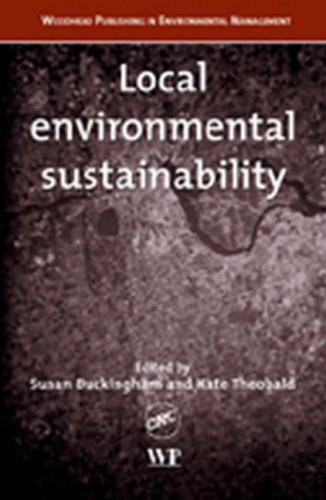

Most ebook files are in PDF format, so you can easily read them using various software such as Foxit Reader or directly on the Google Chrome browser.
Some ebook files are released by publishers in other formats such as .awz, .mobi, .epub, .fb2, etc. You may need to install specific software to read these formats on mobile/PC, such as Calibre.
Please read the tutorial at this link. https://ebooknice.com/page/post?id=faq
We offer FREE conversion to the popular formats you request; however, this may take some time. Therefore, right after payment, please email us, and we will try to provide the service as quickly as possible.
For some exceptional file formats or broken links (if any), please refrain from opening any disputes. Instead, email us first, and we will try to assist within a maximum of 6 hours.
EbookNice Team

Status:
Available4.7
35 reviews
ISBN 10: 1855736853
ISBN 13: 9781855736856
Author: Susan Buckingham
The importance of local programmes in driving sustainable development has been enshrined in Local Agenda 21, arguably the most influential output of the 1992 Rio 'Earth' Summit. Its importance has been reiterated more recently by the Johannesburg Summit in 2002.
Local Environmental Sustainability sets the context for local environmental sustainability and, in particular, considers how local government can promote sustainable development by building partnerships with different groups and organisations in the local community. Using case studies, individual chapters focus on different types of regional and local initiatives, the partnerships that have made them possible, and the key issues in making them effective.
Local Environmental Sustainability provides a blueprint for both local governments and local communities to work together effectively for a more sustainable future.
An important new study focusing on the links between local environmental initiatives and the provision of sustainable services
Includes case studies showing how local government initiatives can work in the community
Considers the relationship between local programmes and the implementation of Local Agenda 21
Chapter 1. Building alliances for local environmental sustainability
1.1 The context for local environmental sustainability
1.2 Local government
1.3 The local state and local civil society: partnerships for environmental sustainability
1.4 Local capacity building
1.5 Structure of the book
1.6 References
1.7 Useful links and web addresses
Chapter 2. Skeletal frameworks: Regional Sustainable Development Frameworks and the issue of climate
2.1 Introduction
2.2 Interpretation of sustainable development
2.3 Role of regions
2.4 Climate change
2.5 Climate change as a regional issue
2.6 Purpose of RSDFs
2.7 Partnership in RSDF preparation
2.8 Treatment of climate change in RSDFs
2.9 Skeletal frameworks
2.10 Conclusion
2.11 Acknowledgements
2.12 References
Chapter 3. Making the wrecker seem not all malevolent: re- regulating the UK's china clay mining ind
3.1 Introduction
3.2 The UK's planning regime for minerals development
3.3 Re-regulating rural environments
3.4 Re-regulating the UK's china clay industry
3.5 Conclusion
3.6 References
Chapter 4. Local Agenda 21 and the shift to 'soft governance'
4.1 The evolution of LA21 in Europe
4.2 Participation and civic engagement in local sustainable development policy making
4.3 Evaluating LA21: the nature and level of civil society engagement
4.4 LASALA and 'soft governance'
4.5 LA21, the 'integration of interests' and the move to' soft governance'
4.6 References
Chapter 5. Combating social exclusion: focus groups, local empowerment and development: a Preston ca
5.1 Introduction
5.2 Defining social exclusion
5.3 Policy approaches to address social exclusion
5.4 The Preston study
5.5 Conclusions on the use of focus groups
5.6 Further case study examples of the use of focus groups in policy making
5.7 Conclusions and wider questions
5.8 References
Chapter 6. Retailing and sustainability: exploring connections using the example of a local town mar
6.1 Introduction
6.2 Skewed meanings: neglecting sustainability
6.3 Towards a new sustainable theory of consumption
6.4 New approaches to old forms of retailing: the sustainable potential of street markets
6.5 Kingston market - a sustainable market culture?
6.6 Research themes: possibilities of a research agenda applying the working matrix
6.7 Conclusion
6.8 References
Chapter 7. Waste minimisation strategies
7.1 Introduction
7.2 Municipal waste in England and Wales
7.3 Individuals and sustainable waste management
7.4 The importance of individuals: waste management in Exeter
7.5 Policy recommendations
7.6 Conclusion
7.7 References
Chapter 8. Trading places: geography and the role of Local Exchange Trading Schemes in local sustain
8.1 Introduction
8.2 Cranes, favours, harmonies and thanks: using LETS currencies
8.3 LETS development in the UK
8.4 LETS and sustainable development
8.5 The case studies: Stroud and Hounslow LETS
8.6 Case study 1 - Stroud LETS
8.7 Case study 2 - Hounslow LETS
8.8 Conclusions
8.9 Acknowledgements
8.10 References
Chapter 9. Allotments and community gardens: a DIY approach to environmental sustainability
9.1 Introduction
9.2 Benefits of allotments and community gardens
9.3 Conclusions
9.4 Acknowledgements
9.5 References
Chapter 10. Local economies, trade and global sustainability
10.1 Introduction: economics and 'local economies'
10.2 Trade and community
10.3 Self-limiting trade: theory
10.4 Self-limiting trade: practice
10.5 Toronto's local economy
10.6 The potential of local economies
10.7 Conclusions
10.8 References
Chapter 11. Inequality and community: the missing dimensions of sustainable development
11.1 The discourse of sustainable development
11.2 Political modernisation and the environment
11.3 The environmental dimension of modernisation
11.4 Alternative approaches
11.5 Inequality and community in nuclear communities
11.6 Environmental change - a new role for planning
11.7 References
Tags: Susan Buckingham, Environmental, Sustainability